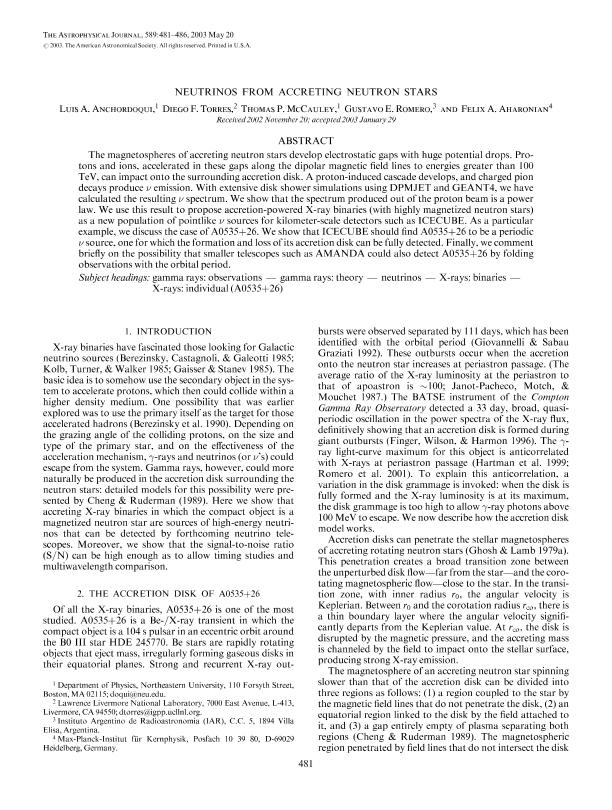Mostrar el registro sencillo del ítem
dc.contributor.author
Anchordoqui, Luis A.

dc.contributor.author
Torres, Diego F.

dc.contributor.author
McCauley, Thomas P.

dc.contributor.author
Romero, Gustavo Esteban

dc.contributor.author
Aharonian, Felix A.

dc.date.available
2017-12-07T17:44:51Z
dc.date.issued
2003-12
dc.identifier.citation
Anchordoqui, Luis A.; Torres, Diego F.; McCauley, Thomas P.; Romero, Gustavo Esteban; Aharonian, Felix A.; Neutrinos from accreting neutron stars; IOP Publishing; Astrophysical Journal; 589; 12-2003; 481-486
dc.identifier.issn
0004-637X
dc.identifier.uri
http://hdl.handle.net/11336/29978
dc.description.abstract
The magnetospheres of accreting neutron stars develop electrostatic gaps with huge potential drops. Protons and ions, accelerated in these gaps along the dipolar magnetic field lines to energies greater than 100 TeV, can impact onto the surrounding accretion disk. A proton-induced cascade develops, and charged pion decays produce ν emission. With extensive disk shower simulations using DPMJET and GEANT4, we have calculated the resulting ν spectrum. We show that the spectrum produced out of the proton beam is a power law. We use this result to propose accretion-powered X-ray binaries (with highly magnetized neutron stars) as a new population of pointlike ν sources for kilometer-scale detectors such as ICECUBE. As a particular example, we discuss the case of A0535+26. We show that ICECUBE should find A0535+26 to be a periodic ν source, one for which the formation and loss of its accretion disk can be fully detected. Finally, we comment briefly on the possibility that smaller telescopes such as AMANDA could also detect A0535+26 by folding observations with the orbital period.
dc.format
application/pdf
dc.language.iso
eng
dc.publisher
IOP Publishing

dc.rights
info:eu-repo/semantics/openAccess
dc.rights.uri
https://creativecommons.org/licenses/by-nc-sa/2.5/ar/
dc.subject
Gamma Ray Observations
dc.subject
Gamma Ray Theory
dc.subject
Neutrinos
dc.subject
X Rays
dc.subject
Binaries
dc.subject
A0535+26 (Estrella)
dc.subject.classification
Astronomía

dc.subject.classification
Ciencias Físicas

dc.subject.classification
CIENCIAS NATURALES Y EXACTAS

dc.title
Neutrinos from accreting neutron stars
dc.type
info:eu-repo/semantics/article
dc.type
info:ar-repo/semantics/artículo
dc.type
info:eu-repo/semantics/publishedVersion
dc.date.updated
2017-11-16T14:43:42Z
dc.journal.volume
589
dc.journal.pagination
481-486
dc.journal.pais
Estados Unidos

dc.journal.ciudad
Chicago
dc.description.fil
Fil: Anchordoqui, Luis A.. Northeastern University; Estados Unidos
dc.description.fil
Fil: Torres, Diego F.. Lawrence Livermore National Laboratory; Estados Unidos
dc.description.fil
Fil: McCauley, Thomas P.. Northeastern University; Estados Unidos
dc.description.fil
Fil: Romero, Gustavo Esteban. Provincia de Buenos Aires. Gobernación. Comisión de Investigaciones Científicas. Instituto Argentino de Radioastronomía. Consejo Nacional de Investigaciones Científicas y Técnicas. Centro Científico Tecnológico Conicet - La Plata. Instituto Argentino de Radioastronomía; Argentina
dc.description.fil
Fil: Aharonian, Felix A.. Max Planck Institut für Kernphysik; Alemania
dc.journal.title
Astrophysical Journal

dc.relation.alternativeid
info:eu-repo/semantics/altIdentifier/doi/http://dx.doi.org/10.1086/374551
dc.relation.alternativeid
info:eu-repo/semantics/altIdentifier/url/http://iopscience.iop.org/article/10.1086/374551/meta
Archivos asociados
